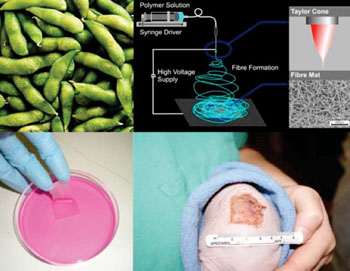Plant-Based Tissue Scaffold Promotes Skin Healing
By HospiMedica International staff writers
Posted on 02 Jul 2014
A new study suggests that an electrospun soy protein-based tissue scaffold (SPS) could enhance reepithelialization during wound healing.Posted on 02 Jul 2014
Developed by researchers at Eqalix (Reston, VA, USA) and the Temple University (Philadelphia, PA, USA) Institute of Regenerative Medicine and Engineering (TIME), the prototype OmegaSkin wound dressing could circumvent current and emerging problems associated with the use of animal protein-based skin substitutes, and could also provide affordable, bioactive scaffolds and dressings for wound healing. A full thickness excisional wound healing study was conducted in a porcine model, which compared wounds dressed with OmegaSkin with control wounds dressed with Tegaderm.

Image: From soy Bean to wound dressing (Photo courtesy of Eqalix).
The study found that while the overall rate of wound closure was similar, there were significant qualitative differences. Two weeks after a single application at the time of wound generation, the OmegaSkin-treated wounds showed robust signs of reepithelialization, which was absent in the control wounds. After 4 weeks, the OmegaSkin-treated wounds contained an epithelial layer in the epidermis that appeared essentially normal, while the connective tissue in dermis was attaining a cellular, organized appearance.
By contrast, the nascent epidermis of the control wounds appeared immature, while the dermis was still replete with numerous inflammatory/immune cells. Standard staining confirmed the increased presence of collagen in the dermis of the OmegaSkin-treated wounds at 4 weeks, while the control wounds were largely devoid of collagen. Four weeks after application of the OmegaSkin dressing, dermal appendages such as sweat glands and hair follicles were observed, while no such appendage formation was observed in the control wounds. The study was published in the June 2014 issue of Wound Medicine.
“Taken together, the histological data indicated that OmegaSkin promoted a more natural mode of tissue regeneration in this porcine model of full thickness excisional wound healing,” said Peter I. Lelkes, PhD, Director of TIME. “Given the similarities between porcine and human wound healing, we anticipate that OmegaSkin may also be advantageous in human applications.”
“In addition to the possibility that OmegaSkin may promote more physiologic healing of wounds, we believe that applying this scalable industrial manufacturing process of electro-spinning to a ‘green’ renewable source like the soybean plant may be able to cut costs significantly, extend availability and shelf life without the need for refrigeration, avoid procurement and processing of animal and human tissues, and eliminate the risk of immunogenic reactions and disease transmission from animal and human products,” added Thomas Seoh, President and CEO of Eqalix.
Related Links:
Eqalix
Temple University














